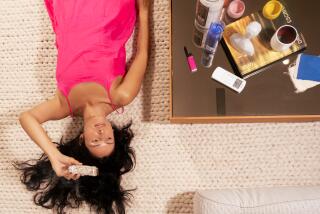Head Strong : Scalp Treatments Attempt to Get to the Root of Hair Weakened by Sun, Styling Appliances and Drying Chemicals
- Share via
WOMEN AND MEN slather their hair in mousse, gel and goo, lacquer it with extra-hold hair spray and then expose it to the ravages of blow dryers, hot curlers, ultraviolet rays and pollution. To compensate, many people condition their hair after every shampoo. But what they forget is that the scalp gets as much abuse as the hair. Because the health of the scalp is as vital to good looks as the condition of the complexion and hair, beauty specialists have developed a new procedure: the scalp treatment.
Similar to facials, scalp treatments combine massage with masques, steam and heat. The intent is to cleanse the scalp, balance its natural oils and deep-condition the hair, resulting in a shiny, manageable, revitalized mane.
Aida Thibiant, whose 15-year-old Beverly Hills skin-care salon has recently expanded to include a hair
parlor, says: “Healthy skin needs regular care to stay in top condition. Just as every skin type benefits from an individualized program of facials, every scalp can use some type of treatment. When the scalp is healthy, the hair is healthy.” She explains that thoroughly cleansing the scalp and massaging it to stimulate blood flow allow each follicle to produce a healthier, stronger head of hair.
Although treatments of questionable value have been used for years to treat baldness, the new procedures are not purported to be a cure for--or even a preventive measure against--genetically caused hair loss. “Keeping the scalp free of pollutants keeps the follicles open and allows hair to grow, but if a follicle is not producing hair for hereditary reasons, scalp treatments aren’t going to reverse nature,” Thibiant explains.
What they can do is help control excess oiliness, improve the appearance of dry hair, control dandruff and prevent hair loss that is related to topical scalp problems. Scalp treatments developed from a field called trichology, which explores hair- and scalp-related diseases. A few trichologists have practiced in the United
States for many years, but the real stronghold is in London, home of the Institute of Trichology, where cosmetologists study for up to three years to become registered trichologists.
British trichologist Philip Kingsley has catered to the tresses of Mick Jagger, Audrey Hepburn and members of the Royal Family in London. His Manhattan clinic also attracts a star-studded clientele, not for high-fashion hair styling, but for high-tech hair care.
Hernan Giraldo is one of the few registered trichologists in Southern California. Based in the Elizabeth Arden Red Door Salon on Rodeo Drive, Giraldo treats problems of the scalp that do not require medical attention. “When a client complains to me of hair loss, I examine the follicle under a microscope to determine if the loss is due to a damaged scalp. When the damage is topical, I can usually solve the problem. If the loss is because of nutrition, emotional trauma or scalp diseases, I refer the client to a doctor or nutritionist.”
Dr. J. L. Ruiz, a Beverly Hills internist, says: “Trichologists can look at a hair and its root and indicate many types of
problems. When I get a referral from a trichologist, his impression of the source of the problem is generally correct.”
Although medical causes may be at the source of hair and scalp problems, most clients seek scalp treatments for cosmetic reasons. The No. 1 complaint is hair that looks like straw. Although chemical processing and alcohol-based styling products dry the hair, Giraldo points out that many people strip their hair with the shampoo they use. “Shampooing every day is fine, but what is used on the hair is critical. In most cases, a moisturizing shampoo for damaged hair is a necessity for Southern Californians. Here, the biggest problem is lack of moisture in the hair. The sun constantly strips the hair of its natural moisture, so it must be replaced.”
Dry hair can be made to look shiny through a process that Giraldo calls “hair reconstruction.”
Deep-conditioning treatments help smooth damaged hair shafts; tints improve the appearance of the hair by restoring sheen. After this intensive procedure, monthly scalp treatments, including a stimulating massage, restore the oil balance of the scalp and result in naturally shiny hair, Giraldo explains.
For oily hair, treatments include masques that absorb excess sebum. Anti-flaking and anti-itching formulas are applied for dandruff. Most treatments include steam phases to restore moisture. When heat is used--to facilitate penetration of masque-type conditioners--the hair is protected with ointments to prevent moisture loss. Procedures take 45 to 90 minutes; prices range from about $35 to $90.
Although the concept of scalp treatments is not new, the need for them is, Thibiant says. “Our environment and our life style combine to ruin our hair, just like they ruin our skin,” she says. “A little extra effort can make a big difference.”
Hair and makeup by Eric Barnard / Cloutier; model: Jaime Hubbard / L.A. Models.


